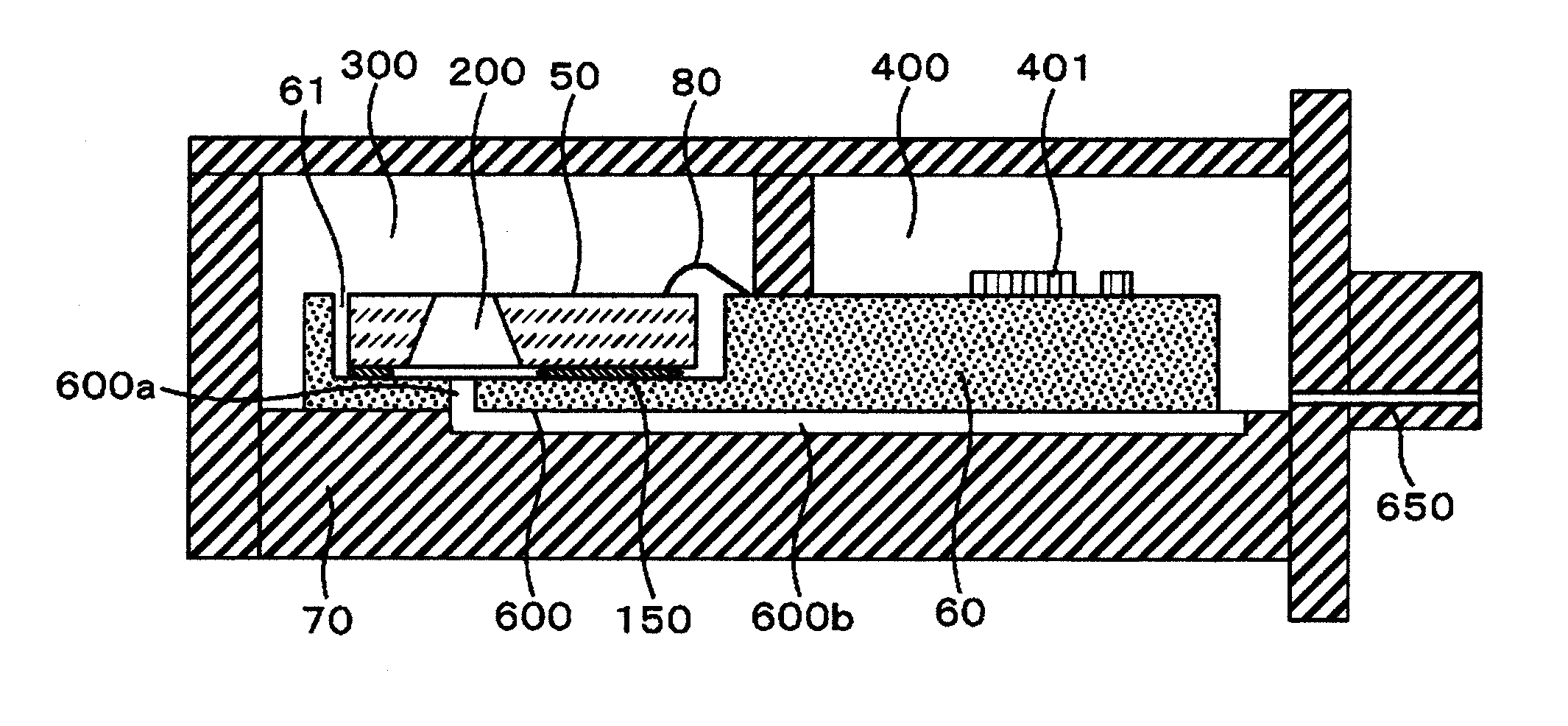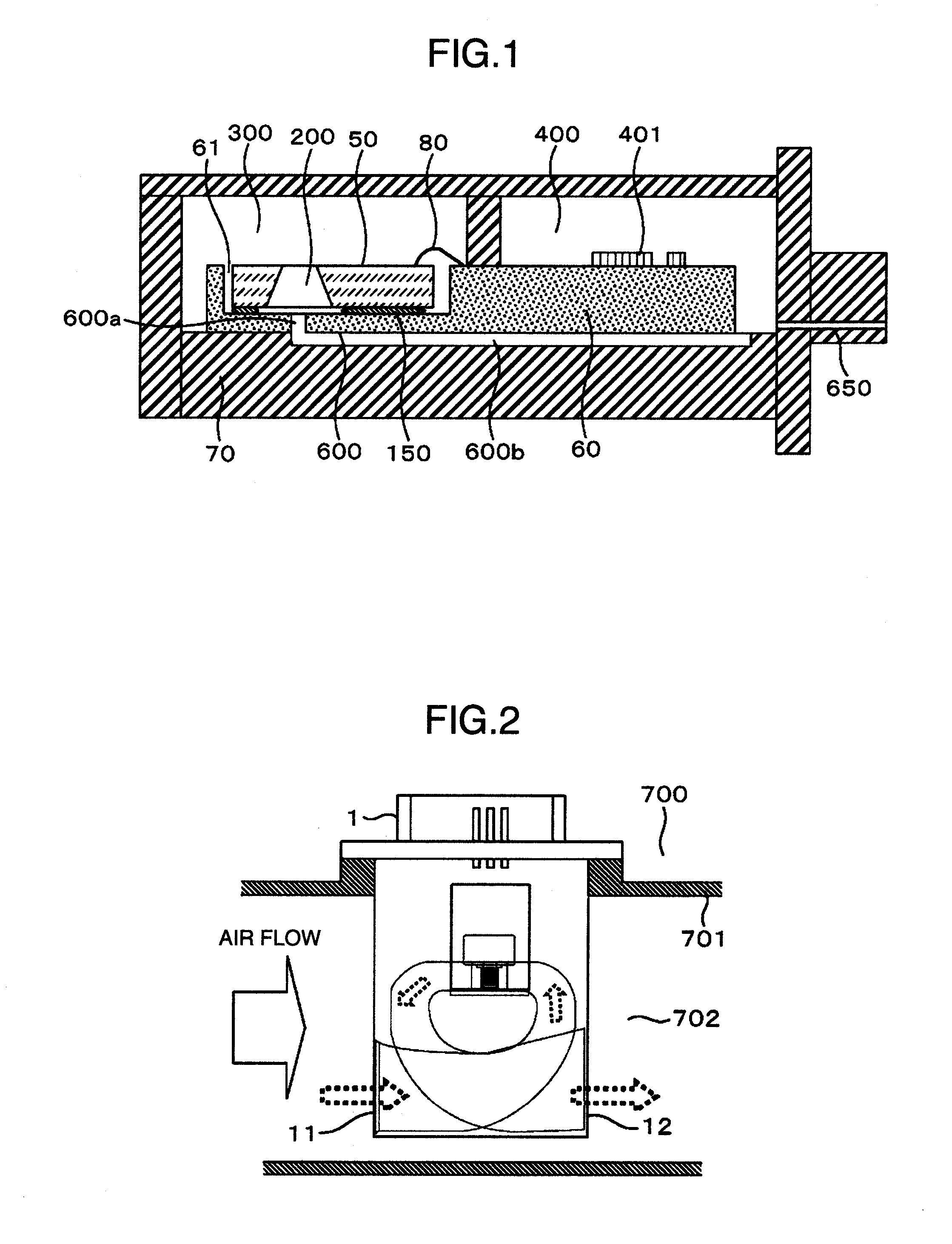Thermal Air Flow Sensor
a sensor and air flow technology, applied in the direction of volume/mass flow measurement, measurement devices, instruments, etc., can solve the problems of difficult dimension clearance control, inability to complete sealing, and liable variation of the mounting surface so as to avoid the breakage of the detecting element, improve the accuracy of measurement, and improve the effect of flow output characteristics
- Summary
- Abstract
- Description
- Claims
- Application Information
AI Technical Summary
Benefits of technology
Problems solved by technology
Method used
Image
Examples
embodiment 1
[0025]FIGS. 1 to 5 schematically show a thermal air flow sensor according to the invention.
[0026]First, an environment, in which the thermal air flow sensor is mount will be described with reference to FIG. 2.
[0027]The thermal air flow sensor 1 is mounted to an intake duct 701 and air flowing in an intake duct interior 702 enters a passage from an upstream side opening 11 of the thermal air flow sensor 1, goes through the passage, and goes out of a downstream side opening 12.
[0028]Also, since an intake duct exterior 700 is completely isolated from the intake duct interior 702, the intake duct exterior 700 is put in a windless state even when air flows in the intake duct interior 702.
[0029]Subsequently, shape of a detecting element will be described with reference to FIG. 3.
[0030]In general, the detecting element 50 is rectangular-shape. A detecting part of the detecting element 50 comprises a thin film region called a diaphragm 55, and the diaphragm 55 is arranged in a passage chamb...
first embodiment
[0032]Subsequently, a first embodiment of a thermal air flow sensor according to the invention will be described with reference to FIG. 1.
[0033]In the present embodiment, the detecting element 50 is mounted on a LTCC (Low Temperature Co-Fired Ceramic) laminated substrate 60 (referred hereinafter to as ceramic substrate). A dent called a cavity 61 is provided in the ceramic substrate 60 so as to enable receiving the detecting element 50.
[0034]The detecting element 50 and the ceramic substrate 60 are connected electrically to each other by an Au wire 80.
[0035]All four sides of the detecting element 50 are bonded in the cavity 61 by means of an adhesive 150 as shown in FIGS. 4A and 4C. At this time, the use of the adhesive forms a clearance in the order of 1 μm˜100 μm between the rear surface of the detecting element 50 and a bottom surface of the cavity 61.
[0036]In this case, in order to isolate the hollow 200 of the detecting element 50 from the passage chamber 300, an application pa...
second embodiment
[0044]FIG. 6 schematically shows a second embodiment of a thermal air flow sensor according to the invention. The second embodiment is the same in fundamental constitution as that of the first embodiment. In the second embodiment, a ventilation hole 600 for communication between a hollow 200 and a circuit chamber 400 is formed in a ceramic substrate 60.
[0045]While the second embodiment adopts a LTCC substrate as a ceramic substrate, on which a detecting element 50 is mounted, in the same manner as in the first embodiment, another ceramic substrate, a print board, or a metallic substrate may be adopted.
[0046]By forming the ventilation hole 600 in a single constituent member, assembling of respective constituent members is increased in degree of freedom of positional tolerance and it is possible to eliminate possibility that the ventilation hole 600 is interrupted at a joint face due to dislocation.
PUM
 Login to View More
Login to View More Abstract
Description
Claims
Application Information
 Login to View More
Login to View More - R&D
- Intellectual Property
- Life Sciences
- Materials
- Tech Scout
- Unparalleled Data Quality
- Higher Quality Content
- 60% Fewer Hallucinations
Browse by: Latest US Patents, China's latest patents, Technical Efficacy Thesaurus, Application Domain, Technology Topic, Popular Technical Reports.
© 2025 PatSnap. All rights reserved.Legal|Privacy policy|Modern Slavery Act Transparency Statement|Sitemap|About US| Contact US: help@patsnap.com



